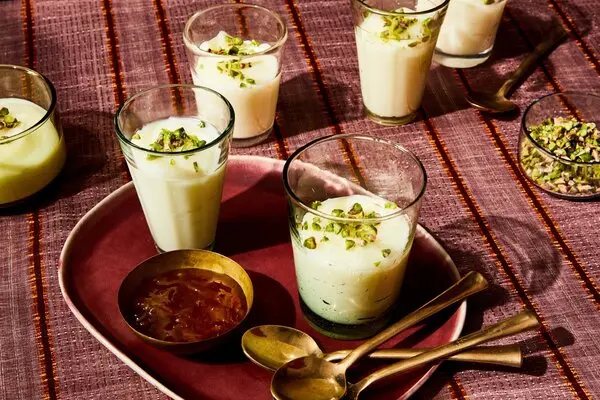Mouhalabieh culture is a key part of Middle Eastern desserts and traditional cuisine. It gives us a peek into the region’s rich history and cultural importance. This article will explore the Mouhalabieh culture, showing why traditional cuisine is so vital in the Middle East.
Mouhalabieh is a beloved traditional dessert in the region. Its importance goes beyond its tasty flavors. Middle Eastern desserts like Mouhalabieh are a big part of the region’s cultural heritage. Knowing their history and cultural context helps us appreciate their value.
Introduction to Mouhalabieh
Mouhalabieh culture is deeply connected to traditional cuisine. Its development has been influenced by various social and cultural factors. By looking into Mouhalabieh’s history and cultural significance, we can better understand the region’s rich cultural heritage. We also see why it’s important to keep traditional cuisine alive.
Key Takeaways
- Mouhalabieh culture is an essential part of Middle Eastern desserts and traditional cuisine.
- Traditional cuisine plays a vital role in preserving cultural heritage in the Middle East.
- Mouhalabieh is a traditional dessert with a rich history and cultural significance.
- Understanding the cultural context of Mouhalabieh is essential to appreciating its value.
- Mouhalabieh culture is deeply rooted in traditional cuisine and social factors.
- The evolution of Mouhalabieh has been shaped by various cultural and social influences.
Understanding the Essence of Mouhalabieh Culture
Mouhalabieh is a dessert with deep roots in Middle Eastern cuisine. It has been passed down through generations, with each family adding its own twist. This has created a rich tapestry of regional variations, showing the diversity of food traditions in the region.
The cultural significance of Mouhalabieh is huge. It’s often served at special occasions like weddings and holidays. It’s seen as a symbol of hospitality and generosity. The art of traditional preparation is also key, with intricate designs and patterns adding to its beauty.
Origins in Middle Eastern Cuisine
Mouhalabieh is believed to have started in the Middle East, where it was a sweet treat for guests. It then spread to other parts of the world, with each region adding its own twist to the recipe.
Cultural Significance Across Generations
Mouhalabieh has played a big role in shaping the Middle East’s cultural heritage. It’s a dish that brings people together, with its preparation often a family affair. Its inclusion in traditional celebrations shows its cultural significance.
The Art of Traditional Preparation
The traditional preparation of Mouhalabieh is an art form. It’s made with ingredients like milk, sugar, and rose water, creating a delicate and creamy texture. The presentation is also key, with intricate designs and patterns adding to its beauty.
In conclusion, Mouhalabieh is a dessert deeply rooted in cultural heritage and food traditions. Its regional variations and traditional preparation methods make it a unique and delicious treat worth exploring.
The Historical Journey of Mouhalabieh
Mouhalabieh’s roots go back to the ancient Middle East. It was shaped by many civilizations, including the Ottoman Empire. This has made its flavor and importance in the region unique.
Knowing Mouhalabieh’s history helps us see its value in Middle Eastern culture. It has been a beloved dessert for centuries. Ingredients like rose water and orange blossom are key to its Middle Eastern taste.
- The introduction of new ingredients and cooking techniques by the Ottoman Empire
- The adaptation of Mouhalabieh to local tastes and preferences in different Middle Eastern countries
- The preservation of traditional recipes and cooking methods despite the influence of modern cuisine
Mouhalabieh is more than just a dessert. It connects us to the past and brings people together. Its history and tradition make it a treasure in Middle Eastern culture.
Essential Ingredients and Their Symbolic Meaning
Mouhalabieh’s unique taste and smell come from its key ingredients. These ingredients carry deep symbolic meanings. They reflect the Middle Eastern community’s culture and values.
Ingredients like semolina flour and sugar are chosen for their taste and texture. But they also hold symbolic meanings. Semolina flour stands for hospitality and generosity. Sugar represents joy and celebration. Together, they make Mouhalabieh a dish that’s both tasty and meaningful.
Traditional Base Components
The traditional ingredients of Mouhalabieh are semolina flour, sugar, and milk. Rose water and orange blossom are added for a unique flavor and aroma. The fragrance of rose water and orange blossom is key to Mouhalabieh’s symbolic meaning.
Regional Ingredient Variations
While the core ingredients of Mouhalabieh stay the same, different regions have their own twists. Some use coconut milk instead of regular milk. Others add nuts or dried fruits to their Mouhalabieh.
The Role of Rose Water and Orange Blossom
Rose water and orange blossom are crucial in Mouhalabieh. They add to the dish’s flavor and aroma. But they also symbolize love, beauty, and fragrance. This makes Mouhalabieh a dish that’s not just delicious but also full of meaning and symbolism.
Traditional Preparation Methods and Techniques
Middle Eastern cuisine values traditional preparation, and Mouhalabieh is no different. Making Mouhalabieh involves careful steps from start to finish. Techniques like stirring and heating are key to getting the right texture and taste.
Preparing Mouhalabieh is often a family activity in Middle Eastern homes. Each family adds its own special touch to the recipe. Ingredients like milk, sugar, and rose water are used to make a sweet and fragrant dessert.
- Mixing the ingredients: Combine milk, sugar, and rose water in a big pot. Heat it gently.
- Cooking the mixture: Let it cook for hours, stirring now and then, until it thickens.
- Adding flavorings: After thickening, add orange blossom water and pistachios for extra flavor and texture.
By following these steps, you can make a delicious Mouhalabieh. It’s a great way to enjoy Middle Eastern cuisine’s rich flavors and traditions, whether you’re an experienced cook or just starting out.
Regional Variations Across the Middle East
Mouhalabieh is a traditional dessert in Middle Eastern cuisine. It shows many regional variations. These changes reflect the cultural differences and unique ingredients in each country. From Lebanon to Egypt, each region has its own version of this dessert.
In Middle Eastern cuisine, regional variations bring a wide range of flavors and textures. Different ingredients, like rose water and orange blossom, give the traditional recipe a unique twist. For example, Lebanese versions often have a sweet and tangy mix, while Syrian ones are richer and more indulgent.
Lebanese Interpretations
Lebanese Mouhalabieh is light and airy. It uses whipped cream and toasted nuts to achieve this texture. This version is a big part of Lebanese cuisine, often served at special events.
Syrian Adaptations
Syrian Mouhalabieh is creamy and rich. It’s made with honey and pistachios, giving it a unique flavor. This shows how cultural differences and regional tastes shape the dessert.
Egyptian Variations
Egyptian Mouhalabieh combines traditional and modern flavors. It often includes coconut and tropical ingredients. This version reflects the cultural exchange and diversity in Middle Eastern cuisine.
These regional variations show the diversity of Middle Eastern cuisine. They also highlight the cultural differences that influence Mouhalabieh’s flavor. By exploring these variations, we can better understand the rich cultural heritage and traditions behind this beloved dessert.
The Role of Mouhalabieh in Celebrations
Mouhalabieh is a big part of Middle Eastern celebrations. It brings people together with its rich cultural meaning. This traditional dessert is a must-have at weddings, holidays, and cultural events.
In these celebrations, Mouhalabieh is more than just a sweet treat. It’s a sign of hospitality and generosity. Its beautiful presentation and flavors add to the festive vibe. This makes it a cherished part of the cultural heritage.
- Traditional preparation methods, which are often passed down through generations
- Unique flavors and ingredients, which reflect the region’s cultural diversity
- Beautiful presentation, which adds to the festive atmosphere
Mouhalabieh is a key part of Middle Eastern celebrations. Its cultural importance keeps growing.
Mouhalabieh is crucial in keeping the region’s cultural heritage alive. It reminds us of the importance of traditional desserts in uniting people. Whether it’s a wedding, holiday, or cultural event, Mouhalabieh is always a hit. Its cultural significance inspires new generations.
Modern Interpretations and Fusion Adaptations
Mouhalabieh, a traditional dessert, has seen big changes lately. Modern twists and fusion cuisine have made it fresh again. These changes have made it more appealing to many people.
New flavors and ingredients have been added to Mouhalabieh. Spices, nuts, and chocolate are now common. This has led to many unique Mouhalabieh versions, each with its own special taste.
Contemporary Twists on Classic Recipe
Today, chefs and home cooks are always trying new things with Mouhalabieh. They mix in flavors from around the world. This makes Mouhalabieh a mix of old and new, showing off today’s tastes.
Global Culinary Influences
Global flavors have really shaped Mouhalabieh today. Ideas and tastes from different places have made it richer. Now, Mouhalabieh shows off the world’s diverse food scene, thanks to modern and fusion cooking.
Serving Traditions and Presentation Styles
Mouhalabieh’s serving ways have changed over time. They mix old techniques with new plating styles. The way it’s presented is as key as how it’s made, making the experience better.
Traditionally, Mouhalabieh is served with fancy garnishes like fresh flowers or nuts. These add to its beauty. Now, chefs and home cooks are getting creative with presentation.
They use modern plating to make Mouhalabieh look amazing. This has made it a hit for big events and celebrations.
Traditional Garnishes
Today, rose petals and pistachios are still used to make Mouhalabieh look elegant. They add flavor and texture. Modern plating also includes fresh fruits and nuts for extra sweetness and crunch.
Modern Plating Techniques
Modern plating has changed how Mouhalabieh is served. It focuses on creativity and looks. Chefs use techniques like spherification and foamification to make it visually stunning.
This has made Mouhalabieh a favorite in restaurants and for special events. Presentation is as important as taste and quality.
Health Benefits and Nutritional Value
Mouhalabieh is a traditional Middle Eastern dessert with many health benefits. It’s made with rose water and semolina flour. These ingredients add antioxidants and fiber to the dessert.
Here are some key health benefits of Mouhalabieh:
- High fiber content from semolina flour, which can help with digestion and satiety
- Antioxidant properties from rose water, which can help protect against cell damage and inflammation
- Lower sugar content compared to other desserts, making it a relatively healthier option
To make Mouhalabieh even healthier, try using natural sweeteners like honey or maple syrup. Also, reduce the sugar content. These changes will help you enjoy Mouhalabieh’s traditional ingredients and nutritional value. They also support your overall health and well-being.
Preserving and Passing Down Mouhalabieh Traditions
Mouhalabieh is more than a dessert; it’s a symbol of culture that unites people. To keep this tradition alive, we must focus on preserving culture and sharing family recipes. This can be done through cooking classes, cultural festivals, and storytelling.
Family recipes are key in keeping Mouhalabieh traditions alive. They are passed down through generations, with each family adding their own touch. By sharing these recipes, we help preserve Mouhalabieh’s cultural heritage for the future.
Family Recipes and Stories
Sharing family recipes and stories is a great way to preserve Mouhalabieh traditions. This can be done through cookbooks, food blogs, or social media. By sharing these stories, we keep Mouhalabieh’s cultural heritage alive and inspire others to do the same.
Cultural Preservation Efforts
Cultural preservation is vital in protecting Mouhalabieh. This can be done through cultural festivals, cooking classes, and workshops. By participating in these events, people can learn about Mouhalabieh’s traditional cuisine and its cultural significance.
Efforts like cultural centers, museums, and historical societies help preserve Mouhalabieh’s heritage. These organizations work to keep Mouhalabieh’s cultural heritage alive, including its traditional cuisine. Supporting these efforts ensures Mouhalabieh’s heritage is preserved for future generations.
In conclusion, preserving Mouhalabieh traditions is crucial. By focusing on cultural preservation, family recipes, and traditional cuisine, we can keep this heritage alive for years to come.
Conclusion: The Enduring Legacy of Mouhalabieh
Mouhalabieh is more than a dessert; it’s a symbol of the Middle Eastern cuisine’ rich cultural legacy. It has been passed down through generations. The art of making Mouhalabieh has changed but kept its core essence.
The scent of rose water and orange blossom in each bite shows the heritage of Middle Eastern cooking. It reminds us of the need to keep and celebrate our cultural traditions. Enjoying Mouhalabieh connects us to our community’s history.
Mouhalabieh’s lasting appeal shows that old flavors can still excite us today. By sharing these recipes, we keep the cultural legacy of Mouhalabieh alive for future generations.



